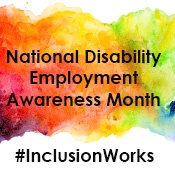Hello everyone! Did you know that October is designated as National Disability Employment Awareness Month? (See https://www.dol.gov/odep/topics/ndeam/ for more information.) This year’s theme is #InclusionWorks which provides a great foundation as we start the school year.
Speaking of the beginning of school, I was so excited to visit schools during the opening weeks and watch students reunite with old friends, meet new ones, and walk into the classrooms with enthusiasm. I also noticed a few changes and wondered if these were new or a resurrection and rejuvenation of past classroom practices. Seemed to me that more students with diversity were included throughout the day, and many classroom environments and approaches to learning are shifting. I saw lessons designed with expanded learning experience options, there were varied expressions of learning that encouraged creativity and increased technology use, and integration of multiple modalities being utilized- across all grade and content levels.
This observation and wondering inspired me to dig a little deeper by talking to educators and community members throughout our region. I have now learned that the word “inclusion” means many different things to different people. To some, the word is firmly rooted in Special Education services. Others view it in a broader context; inclusion as going beyond making our classrooms welcoming (which is always a good thing), to creating a genuine feeling of belonging in our classrooms. Dr. Ilene Schwartzreally sums it up in the first minute and a half of a video she created for teachers and other leaders: watch video
As I watched the beginning of the video by Dr. Schwartz, I thought about the many occasions in which I have been part of organizations that focused on “being welcoming”. Welcoming is good, but it seems temporary, almost like you are a guest. Creating belonging for all is a bigger commitment, and is something we should strive to create for adults, and the children we serve. Students with social/behavioral challenges, language differences, struggles at home, gender identity questions, health concerns and other issues deserve a learning environment that recognizes their uniqueness and contributions. We all know that supporting cohesive, collaborative, and welcoming learning communities for students and adult learners is a huge challenge, it isn't something that we can create or fix with a single program or training. We can hold the idea of belonging in our thoughts as we plan instruction, have conversation with parents, students, and colleagues, and take advantage of several great resources that already exist. Change takes time, and it is everyone’s job to remember to keep issues of belonging a priority.
After checking with other colleagues in the field, it turns out that inclusionary practices that use strategies such as Differentiated Instruction (DI) and Universal Design for Learning (UDL) have been around for some time. They were even around during my grandmother’s early teaching days in the late 70’s. Now they are being used more extensively as tried and true practices for reaching more diverse student and improving outcomes for all students. With the push for educational inclusion and dis-ABILITY awareness since the 70’s, and further efforts culminating with the latest version of the Americans with Disabilities Act (ADA) being signed into law on July 26, 1990, the numbers of individuals with disabilities employed has skyrocketed, making belonging a reality. As we move along this year, additional supports and services for students identified with or at high risk for developing a disability condition will be piloted and developed in conjunction with the Department of Vocational Rehabilitation, OSPI, and the Center for Change and Transition Services. These are truly exciting times in the field of education and especially for students and adults who are included; experiencing belonging in their communities, pride, and a sense of accomplishment.
To sum it up…
“Inclusion is not a set of strategies or a placement issue [emphasis added].
Inclusion is about belonging to a community- a group of friends, a school community, or a neighborhood.”
(Allen and Schwartz, 2001, p.4)
I’ve provided a few links to handy resources below, and hope you find these links a gateway to deeper learning:
Region X Equity Assistance Center provides tools to support educators as they work to provide students with meaningful instruction. This guide provides a wide range of practices supported by research and is available as a download (free of cost).
Differentiated Instruction
Differentiating instruction for a wide range of learners is a challenge for all educators, regardless of subject or grade level. ASCD provides a wealth of resources that can help us in this work. The link below includes several things: two really helpful infographics about what differentiated instruction is and is not, as well as videos/archived webinars (many of which are free of charge).
Social Emotional/Behavioral Supports
Following recent legislative changes and RCW revisions regarding behavior supports and discipline practices, OSPI updated their Strengthening Student Educational Outcomes documents, including the 2016 Behavior Menu of Best Practices and Strategies. There are multiple resources cited in this updated publication.
I also found out that the U.S. Department of Education sponsors a technical assistance center for Positive Behavioral Interventions and Supports—such a wealth of info to explore @ http://www.pbis.org/ ! While one’s first tendency might be to see this as a Special Education resource, most of the tools and strategies provided are intended for use across schools, with all students.Positive behavior interventions and supports start with whole school (school-wide and classroom practices), then refines the focus to secondary levels for individuals and small groups who respond to more personalized supports. At the third level, individualized interventions are provided: The link below takes you to a variety of Tier 3 supports for use across classrooms (note the horizontal menu titled RESOURCES @ http://www.pbis.org/school/tier3supports.)
I hope you have anopportunity to experience first-hand the benefits of inclusionary practices, and please share these resources along with others you find helpful.
Ed



